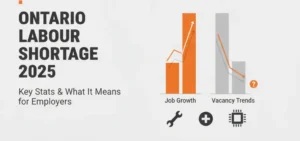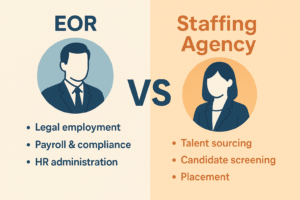It feels like everyone is stretched thin these days. For a growing number of your employees, that feeling might be because they’re heading to another job after finishing their shift with you. A recent, eye-opening report has revealed that one-third of Canadians working multiple jobs is now the reality. This trend, often called “poly-employment,” is a significant shift in the labour market, and it’s driven less by ambition and more by necessity.
For Ontario business owners and HR managers, this isn’t just a curious statistic—it’s a critical piece of workforce intelligence. Understanding why this is happening and what it means for your team is the first step toward building a more resilient and supportive workplace.
Why Are So Many Canadians Working Multiple Jobs?
The primary driver behind this trend is no surprise: the soaring cost of living. While headlines often focus on wage growth, the reality for many is that their primary paycheque no longer covers basic expenses like housing, groceries, and transportation. Stagnant wages in certain sectors, coupled with persistent inflation, have created a perfect storm where a single income source is simply not enough.
However, it’s not purely about financial survival. Other factors contributing to the rise of poly-employment include:
- Underemployment: Some employees may be in part-time or contract roles that don’t provide enough hours. They take on additional jobs to piece together a full-time income.
- Skill Development: A smaller segment of this group uses a second job to gain experience in a new field or build a specific skill set they can’t develop in their primary role.
- Passion Projects: For a lucky few, a second job is a way to pursue a passion or hobby, turning it into a small side business or freelance gig that brings in extra cash.
Regardless of the reason, the presence of so many Canadians working multiple jobs has direct implications for their primary employer.
“When a third of the workforce is juggling multiple professional commitments, employers can no longer assume they are getting their employees’ full, undivided attention.”
The Hidden Risks of an Overextended Workforce
When an employee is working a second or even third job, it can create a ripple effect of challenges that you, as the employer, will inevitably have to manage. Recognizing these potential issues is crucial for maintaining productivity, safety, and a positive workplace culture.
1. Employee Burnout and Fatigue
This is the most significant risk. An employee working 50, 60, or even more hours per week is on a fast track to burnout. Chronic fatigue not only impacts their well-being but also leads to:
- Increased absenteeism and presenteeism (being at work but not productive).
- A higher likelihood of mistakes and a drop in work quality.
- A greater risk of workplace accidents, especially in safety-sensitive roles.
2. Decreased Engagement and Loyalty
An employee’s focus and energy are finite resources. If they are spread across multiple jobs, their connection to your company can weaken. Their primary role may start to feel like just one of several obligations rather than a career. This can lead to lower engagement in team projects, reduced participation in company culture, and a higher turnover rate as they seek a single job that can meet their financial needs.
3. Potential Conflicts of Interest
Depending on the nature of their other job, conflicts of interest can arise. This is particularly concerning if their second job is with a competitor, a client, or a supplier. Even if it’s in a completely different industry, scheduling conflicts and the use of company resources (even unintentionally) can become problematic. It’s essential to have a clear policy on this to protect your business interests.
What Ontario Employers Should Do Next
Ignoring this trend is not an option. Proactively addressing the factors that lead to poly-employment can improve retention, boost productivity, and position your company as an employer of choice. Here are three actionable steps you can take right now.
- Review Your Compensation Strategy: The most direct way to address the financial pressures on your employees is to ensure you are offering a competitive wage. Conduct a market analysis to see how your pay scales compare to the industry standard and the local cost of living. If a significant wage increase isn’t feasible, consider other financial wellness benefits like profit-sharing, performance bonuses, or providing access to a financial advisor.
- Implement a Clear “Outside Work” Policy: Don’t wait for a conflict to arise. Develop or update your employee handbook to include a clear and fair policy on outside employment. This policy should require employees to disclose any outside work that could pose a conflict of interest, ensuring transparency without being overly restrictive. The goal is to protect the business, not to control your employees’ personal time.
- Prioritize Employee Well-being and Flexibility: Acknowledge that your employees have lives outside of work. Promote a healthy work-life balance by offering flexible work arrangements where possible, such as flexible hours or hybrid work options. Encourage employees to use their vacation time and ensure managers are trained to spot the early signs of burnout. A supportive environment can make your workplace the one an employee prioritizes.
Ultimately, the rise of Canadians working multiple jobs is a reflection of broader economic challenges. By taking thoughtful, proactive steps, you can mitigate the risks to your business and create a workplace where your employees can thrive, not just survive.
Need help navigating HR changes? Book your free HR audit today or speak with our team about how Divino can support your business.
Sources
- HR Reporter. (2025). One-third of Canadians are working multiple jobs. Retrieved from https://www.hrreporter.com/news/hr-news
- Statistics Canada. (2025). Labour Force Survey. Retrieved from https://www150.statcan.gc.ca/n1/daily-quotidien/251003/dq251003a-eng.htm




